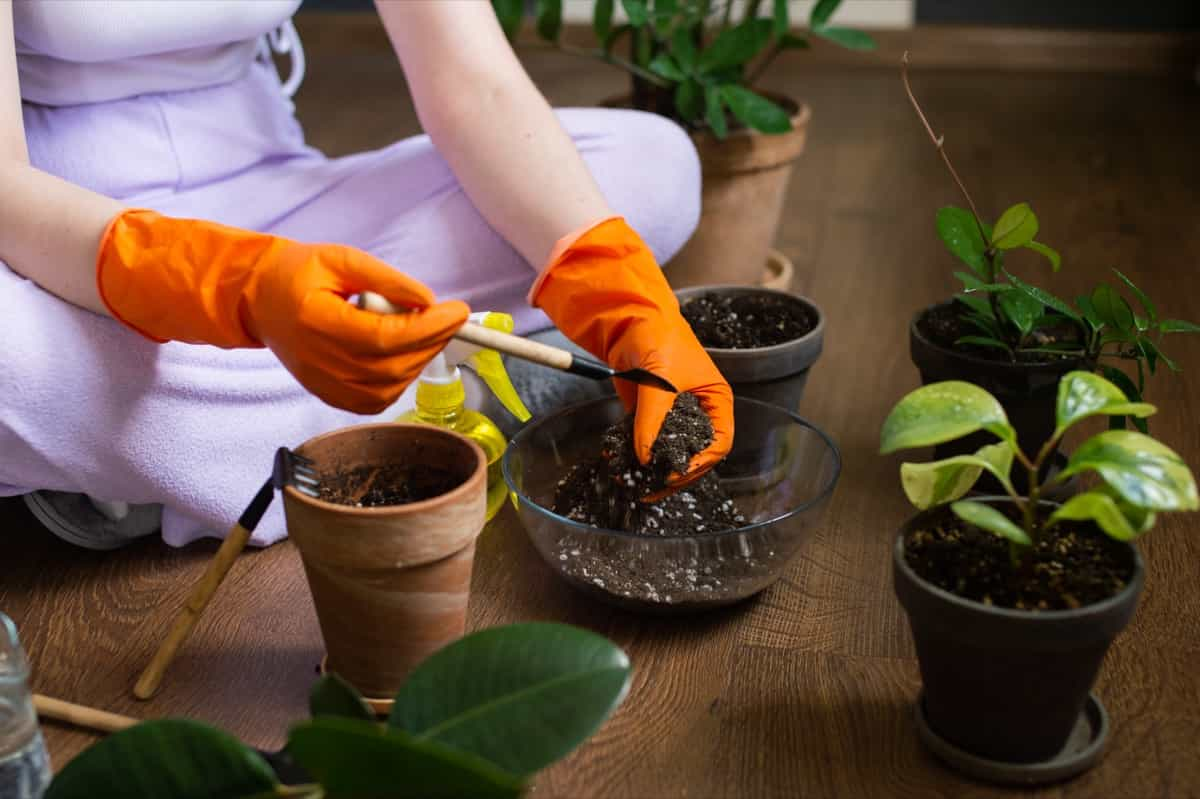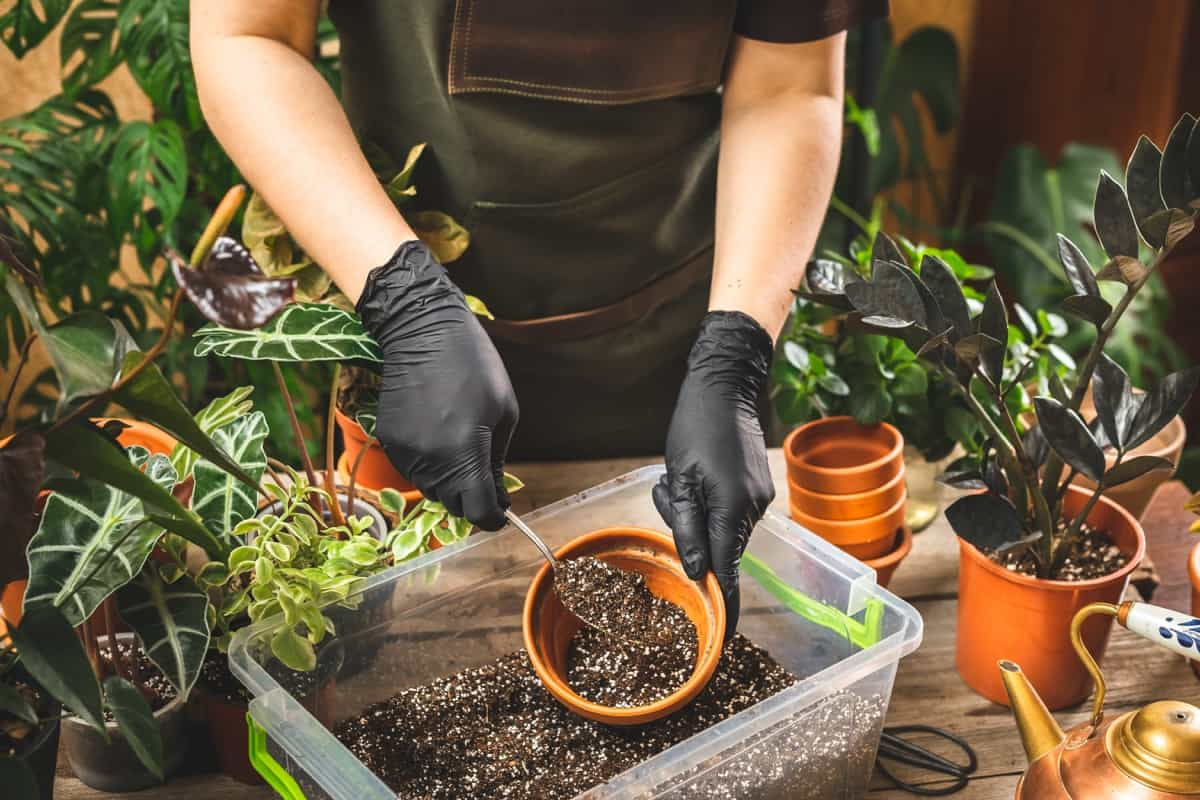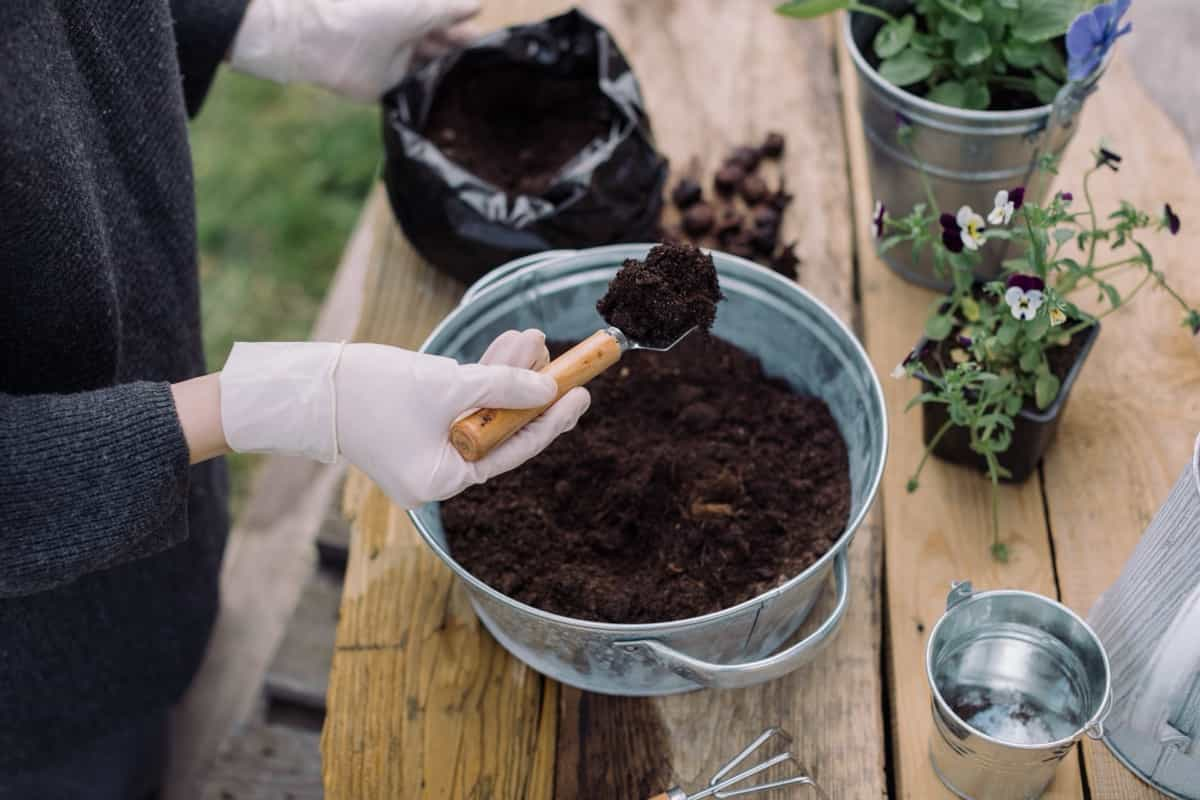Making an informed decision about whether to use organic or inorganic potting soil requires understanding what will best meet the needs of your plants and growing conditions. Remember, healthy soil leads to healthy plants. So, take some time to research and experiment with different Potting soil mix options until you find what works best for you and your green companions.

Organic vs Inorganic Potting Soil Mixes
Organic Potting Soil Mix Composition
Organic potting soil mixes are made from natural materials such as compost, peat moss, and coconut coir. These ingredients provide essential nutrients and promote healthy plant growth. Compost, a key component of organic potting soil mixes, is rich in organic matter that helps improve soil structure and fertility. It also enhances water retention and promotes beneficial microbial activity in the root zone.
Peat moss, another common ingredient, aids in moisture retention while providing good drainage to prevent overwatering. Coconut coir is an alternative eco-friendly way to peat moss and serves as an excellent medium for retaining moisture without becoming waterlogged. Its fibrous nature allows for better airflow around the roots.
Organic potting soil mixes often contain additional natural additives like worm castings or bat guano. These additions help enrich the overall nutrient content of the mix and provide essential trace elements necessary for plant growth. The combination of these organic materials creates a well-balanced potting soil mix that supports healthy root development, enhances nutrient availability,
Inorganic Potting Soil Mix Composition
Inorganic potting soil mixes typically consist of a combination of materials such as vermiculite, perlite, and sand. These components provide excellent drainage properties, allowing excess water to flow through the mix easily. Additionally, inorganic mixes tend to have a more stable structure compared to their organic counterparts. This means they are less likely to break down over time or compact under pressure. The improved stability allows for better air circulation within the root zone and helps prevent compaction that could hinder plant growth.
In case you missed it: Common Mistakes to Avoid When Mixing Your Potting Soil

Nutrient Availability
When choosing the right potting soil mix for your plants, one important factor to consider is nutrient availability. In organic potting soil mixes, nutrients are derived from natural sources such as composted materials, manure, and other organic matter. These materials slowly release nutrients over time as they break down, providing a steady source of nourishment for your plants. This slow-release nature helps prevent nutrient burn or overload.
On the other hand, inorganic potting soil mixes often contain synthetic fertilizers that provide an immediate boost of nutrients. These fertilizers are typically formulated with specific ratios of nitrogen, phosphorus, and potassium. While this can be beneficial for certain plants with high nutrient demands or specific deficiencies, it may not provide a balanced and sustainable long-term solution.
The choice between organic and inorganic potting soil mixes depends on your specific gardening goals and preferences. If you prioritize natural nutrient availability over quick fixes or want to minimize synthetic inputs in your garden routine, then organic potting soil mixes may be the way to go. However, if you require precise control over plant nutrition or need targeted supplementation for species or conditions, an inorganic option might suit you better.
Water Retention and Drainage
When it comes to potting soil mixes, one crucial aspect to consider is water retention and drainage. Organic potting soils typically contain components like compost, peat moss, or coconut coir that have excellent water-holding capacity. These materials can retain moisture for longer durations, which is beneficial for plants that thrive in consistently moist conditions. Additionally, organic mixes tend to have a spongy texture that promotes even distribution of water throughout the container.
On the other hand, inorganic potting soils often incorporate materials such as perlite or vermiculite, which enhance drainage. These lightweight additives allow excess water to flow freely through the soil mix and prevent overwatering or root rot. Inorganic mixes are ideal for plants that prefer drier growing conditions or require frequent watering. It’s important to assess your specific plant’s needs before choosing a potting soil mix. Some plants may benefit from a mix with higher water retention abilities, while others will thrive with improved drainage properties.
Soil pH Levels
Soil pH levels play a key role in the overall health of your plants. It refers to the acidity or alkalinity of the soil, which can greatly influence nutrient availability to your plants. In organic potting soil mixes, pH levels tend to be more balanced and neutral. This is because organic materials like compost have a natural buffering capacity that helps maintain optimal pH levels for most plants.
In case you missed it: Best Ways to Add Phosphorus to Your Soil for More Yields and Profit

On the other hand, inorganic potting soils often have a higher pH due to additives like limestone or perlite. Maintaining the right pH level is important because it affects how well plants can absorb nutrients from the soil. By using organic potting soil mixes with proper pH balance, your plants have access to all the necessary nutrients they need for healthy growth. However, it’s important to note that some specialized plant species may require specific pH conditions for optimal growth.
Aeration and Structure
When it comes to potting soil mixes, aeration, and structure play a crucial role in the overall health and vitality of your plants. Organic and inorganic potting soil mixes differ in their ability to provide optimal aeration and structure for plant roots. In organic potting soil mixes, materials such as compost, peat moss, and coconut coir are commonly used to improve aeration.
These organic components create air pockets within the soil, allowing oxygen to reach the roots. This is especially important for plants that require well-drained soil or have sensitive root systems. On the other hand, inorganic potting soils often contain perlite or vermiculite as additives. These lightweight materials enhance drainage and prevent compaction by improving airflow within the soil mix. They also help maintain an open structure that allows roots to penetrate easily.
The presence of beneficial microorganisms can further enhance the aeration and structure of organic potting soils. These microscopic creatures break down organic matter over time, creating channels for air movement while maintaining stability within the mix. However, it’s worth noting that excessive reliance on certain organic amendments can lead to compacted soils with poor drainage. Therefore, finding the right balance between organic matter content and structural integrity is key when using these types of potting mixes.
Sustainability and Environmental Impact
When it comes to choosing a perfect potting soil mix for your plants, considering its sustainability and environmental impact is crucial. Environmentally conscious gardeners often favor organic potting soil mixes due to their natural composition. These mixes are typically made from renewable resources such as composted bark, coconut coir, or peat moss. In contrast, inorganic potting soil mixes may contain components like perlite or vermiculite that are mined from non-renewable sources.
The extraction of these materials can have a negative impact on the environment. Furthermore, organic potting soil mixes tend to be more eco-friendly because they encourage healthy microbial activity in the soil. This promotes nutrient cycling and reduces the need for synthetic fertilizers, which can leach harmful chemicals into the environment.
Cost
Cost is an important factor to consider when choosing the right potting soil mixes. Organic potting soil is more expensive than its inorganic counterpart. This is because the ingredients used in organic mixes, such as compost and natural fertilizers, are generally pricier than synthetic alternatives. However, it’s essential to look beyond the initial cost and consider the long-term benefits of using organic potting soil.
In case you missed it: Common Mistakes to Avoid When Mixing Your Potting Soil

While you may pay more upfront, organic mixes often provide better nutrient availability and promote healthier plant growth. This can lead to a reduced need for additional fertilizers or amendments down the line, ultimately saving you money in the long run. On the other hand, inorganic potting soils are typically cheaper due to their use of synthetic components like perlite or vermiculite. These materials are readily available and less expensive than organic additives.
Suitability for Different Plants
When choosing the right potting soil mix, one important factor to consider is its suitability for different types of plants. Not all plants have the same nutrient requirements or prefer the same growing conditions, so selecting the appropriate mix is crucial for their health and vitality. Organic potting soil mixes are often preferred by gardeners who prioritize natural and sustainable gardening practices. These mixes are typically made from a combination of compost, peat moss, coconut coir, and other organic materials.
On the other hand, inorganic potting soil mixes usually consist of synthetic materials such as perlite, vermiculite, or expanded clay pellets. These mixes offer excellent drainage properties and are particularly suitable for plants that require well-aerated roots and prefer drier conditions. Certain plant varieties like succulents or cacti thrive in sandy soils with good drainage to prevent root rot. Inorganic potting soil mixes with high levels of perlite or sand can provide these specific needs perfectly.
Aesthetic Appeal
When it comes to potting soil mixes, the aesthetic appeal may not be the first thing that comes to mind. However, the appearance of your potting soil can have an impact on the overall look of your potted plants. Organic potting soil mixes often have a rich, dark color that can add depth and beauty to your plant containers. This natural color is visually appealing and can enhance the overall aesthetics of your indoor or outdoor space.
Additionally, organic mixes are often made with ingredients like compost or peat moss, which can provide a nice texture and consistency to the soil. In contrast, inorganic potting soil mixes may appear more uniform in color and texture. These mixes are composed of materials such as perlite or vermiculite, which have a light and airy look. While they may have less visual interest than organic mixes, their clean and consistent appearance can create a sleek and modern feel when paired with contemporary planters.
Disease and Pest Resistance
When it comes to the health of our plants, disease and pest resistance are top priorities. Organic potting soil mixes have a natural advantage in this area. By using organic materials like compost, they create an environment that encourages beneficial microorganisms to thrive. These microorganisms help suppress harmful pathogens and pests. Inorganic potting soil mixes, on the other hand, lack the same level of natural defenses. Without the presence of organic matter and beneficial microbes, these mixes may be more susceptible to diseases and pests.
In case you missed it: How to Propagate Pothos from Leaf Cuttings, Stem Cuttings in Water and the Soil

However, some inorganic mixes may contain added chemicals or pesticides that can help combat these issues. It’s important to note that choosing the right potting mix alone won’t guarantee complete protection against diseases and pests. Proper plant care practices such as regular inspections, pruning infected leaves or branches, and implementing integrated pest management strategies are still crucial.
Ease of Use
One of the factors that gardeners consider when choosing a potting soil mix is its ease of use. Organic potting soil mixes are often praised for their user-friendly nature. They tend to have a looser texture, making it easier to work with and plant seeds or transplants. The high organic matter content also improves the overall structure of the soil, reducing compaction and allowing roots to penetrate easily.
In contrast, inorganic potting soil mixes can be denser due to their composition. This can make planting more challenging as it may require more effort to dig holes or create space for roots. However, some gardeners prefer this compactness as it provides stability for larger plants or trees.
Another aspect that affects ease of use is moisture retention. Organic mixes typically retain water better than inorganic ones, which means less frequent watering for busy gardeners who might need to remember or be able to water daily. On the other hand, inorganic mixes generally have better drainage properties. This can be advantageous if you’re prone to overwatering your plants or live in an area with heavy rainfall where excessive moisture could lead to root rot.
Long-Term Soil Health
Maintaining the long-term health of your soil is crucial for the success of your plants and garden. Both organic and inorganic potting soil mixes can impact the overall health of your soil, but there are some key differences to consider. Organic potting soils typically contain a variety of natural ingredients such as compost, peat moss, and coconut coir. These organic components break down over time, adding nutrients and improving soil structure.
In case you missed it: 15 Indoor Plants That Don’t Cause Allergies: Best Hypoallergenic Plants for Indoor Garden

This gradual decomposition helps create a nutrient-rich environment that promotes healthy root growth and microbial activity. In contrast, inorganic potting soils often rely on synthetic additives like perlite or vermiculite to improve drainage and aeration. In fact, repeated use of inorganic mixes may lead to nutrient depletion and compaction over time.
Conclusion
Potting soil mixes play a vital role in the success of your potted plants. Whether you’re a seasoned gardener or a beginner, understanding the basics of potting soil is essential for healthy plant growth. With so many options available, it’s important to understand the importance of selecting the right potting mix.
- The Role of Watering in Preventing Drying Moringa Pods
- Best Liquid Fertilizer for Flowering Plants
- How to Set Up an Efficient Watering System for Home Garden
- How to Mulch Tulip Bulbs: Expert Tips Best Tulip Blooms
- Common Problems with Potted Figs and How to Solve Them
- How to Prevent Flower Drops in Pomegranate Trees: Effective Tips
- How to Boost Ridge Gourd Flowering and Yield: A Beginner’s Guide
- Effective Pollination Techniques for Maximizing Gourds Yield
- Composting Techniques for Manure in Home Gardens
- A Step-by-Step Guide on Propagation Techniques for Jasmine Plants
- How Do I Make My Garden Less Cluttered: A Beginners Guide
- Growing Red Currants at Home for Beginners
- Gardening Techniques in Planting Vegetables
- Where to Place Indoor Plants in Your Home
- How to Grow Tomatoes Organically at Home: A Comprehensive Guide
- Organic Gardening on a Budget: Low-Cost Methods and Materials
- Gongura Seed Germination and Planting Methods
- Cabbage Seed Germination and Selection
- Broccoli Seed Germination and Selection
- Asparagus Seed Germination and Variety Selection
- Seasonal Flower Gardening: Best Practices for Spring, Summer, Fall, and Winter
- How to Grow Hibiscus from Flower
- Plantation Ideas for Home Decoration: A Beginners Guide
- Flower Garden Designs and Layouts for Beginners
- Planting and Spacing Techniques in Papaya: A Beginner’s Guide
- Growing Gold: Essential Techniques for Planting Pineapples
- How to Make Kalanchoe Plant Bushy: Home Remedies and Solutions
- 11 Reasons Why Your Gardenia is Not Blooming: Home Remedies and Solutions
- Eco Elegance: The Guide to Designing a Drought-Tolerant Landscape
- Gardening on a Slope: Strategies for Hillside Landscaping
- Nourish and Flourish: Top Organic Mulches for Thriving House Plants
- Everything You Want to Know about Indian Mogra Flower: Discover Uses and Growing
- Green Thumb Success: Expert Tips for Cultivating Greenhouse Pumpkins All Year Round
- Maximize Growth & Flavor: The Ultimate Guide to Companion Planting in Herb Gardens
- How to Control Rhododendron Problems Naturally: Home Remedies and Organic Ways to Fix Them
- Natural Magic: The Remarkable Benefits of Cinnamon for Plants